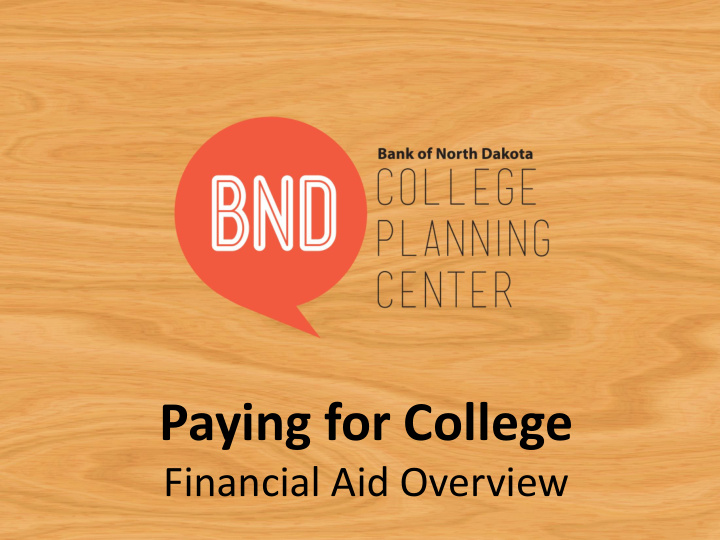



Paying for College Financial Aid Overview
Plan for Success • College Planning Center – bnd.nd.gov • Discover your interests – RUReadyND.com • College Navigator – nces.ed.gov/collegenavigator • College SAVE – Collegesave4u.com
College Expenses • Tuition & Fees • Room & Board • Books & Supplies • Transportation • Miscellaneous Personal Expenses
How Americans Pay for College Grants & Scholarships 31% Parent Income & Savings 30% Student Borrowing 15% Student Income & Savings 12% Parent Borrowing 7% Friends & Relatives 4%
What is Financial Aid • Scholarships • Assistance Programs • State Grants • Federal Grants • Federal Work Study • Federal Student Loans • Non-Federal Student Loans
Where to Find Scholarships • Local businesses & organizations • Library • Colleges/Universities • Religious Organizations • Fraternal Organizations • Employers • Tribal Agencies • State Agencies • Large Corporations • Internet
Internet Addresses • nddfs.org • fastweb.com • finaid.org • scholarships.com • cashe.com
Assistance Programs • AmeriCorps • Vocational Rehabilitation • Employee Assistance • Military Tuition Benefits • Tribal Higher Education • Individual Development Accounts − ND Community Action Partnership − Call 701-232-2452 or visit www.capnd.org
State Grants • Scholars Program • Indian Scholarship: $2,000 • Academic or Career &Tech Ed Scholarship: $1,500 • State Student Incentive Grant: $1,950
What is FAFSA? Free Application for Federal Student Aid • Basic application for student aid • Collects student and family info • School determines financial aid • Completed online – fafsa.gov
Documents for FAFSA • Social Security Number • 2015 Federal Income Tax Return • 2015 Untaxed income records – Veterans non-education benefit records – Child support received – Worker's compensation • Assets – Balance of cash, savings and investments – Know what not to include • Alien registration or permanent resident card (if not a U.S. citizen)
IRS Data Retrieval Tool • Electronically transfers your federal tax return information into your FAFSA • Easy • Fast • Accurate
Is Parent Information Needed? • Independent Student – 24 years of age – Married – US Armed Forces active duty or veteran – Have a child whom they support – At any time after age 13 were in foster care or ward of the court – Emancipated minor – In legal guardianship – Unaccompanied homeless youth – Estranged from parents
When to Complete FAFSA When Student Is When Student Can Which Year Attending Submit a FAFSA Income Tax Information July 1, 2015-June 30, 2016 January 1, 2015 2014 July 1, 2016-June 30, 2017 January 1, 2016 2015 July 1, 2017-June 30, 2018 October 1, 2016 2015 July 1, 2018-June 30, 2019 October 1, 2017 2016 April 15 is the ND Priority Deadline!
Benefits of Prior-Prior Year • File earlier • Aligned with admission process • Certainty • IRS Data Retrieval Tool • Less pressure • Earlier notifications
If Something Changes • Eligible Changes – Lower Income – Family Size – Assets • Special Circumstance Adjustment
FAFSA User ID • Who needs an FSA ID? – Student – Parent of dependent students – Borrowers – Anyone who interact with the Federal Student Aid websites
What do you apply for with FAFSA? • Federal Student Aid – Work Study – Pell Grant – SEOG – TEACH Grant – Direct Loan • State Incentive Grant
Federal Work Study • Say “yes” on FAFSA • Jobs may be on or off campus • Eligible employers: – School – Agencies – Organizations
Federal Grants • Pell Grant: – Up to $5,775 • FSEOG: – Up to $4,000 • TEACH Grant: – $4,000
Pell Grants 2008-09 Pell Grant Recipients by Family Income $50,000 or more 7% $40,001-$50,000 11% $30,001-$40,000 20% $20,001-$30,000 24% $20,000 or less 37% 0% 10% 20% 30% 40%
Student Loans • Federal Direct • Federal PLUS • State DEAL Loan Program • Alternative Loans
Federal Direct Loans • Subsidized : – Government pays interest for student while in-school, grace or deferment status • Unsubsidized : – Government does not pay interest for student; the interest is billed quarterly
Federal Direct Loan Limits Dependent Students • $5,500 – Year 1 • $6,500 – Year 2 • $7,500 – Years 3-5 Independent Students • $ 9,500 – Year 1 • $10,500 – Year 2 • $12,500 – Years 3-5 • $20,500 – Graduates
Federal Direct Loan Details • Student is the borrower • Must be enrolled at least half-time • Sign Master Promissory Note (MPN) • Fixed interest rate (2015-16) – 4.29% undergraduate loans • 1.068% loan fee • Repayment begins after out of school for 6 months
Federal PLUS Loan • Loan in parent’s name • Parent responsible for repaying • Credit application required • Fixed rate = 6.84% • 4.272% loan fees • Repayment begins after 60 days • Must sign Master Promissory Note (MPN)
State DEAL Loan • Dakota Education Alternative Loan • FAFSA required • Low interest rate • Fixed or variable • No tiers • Credit worthy cosigner if under 24 • Deferment options
Alternative Loans • Variable interest rates • Tiers based on credit • Cosigner may be required • Terms vary among lenders • Wells Fargo • Discover • Sallie Mae
What is the average student loan debt in North Dakota? A. $27,400 B. $37,400 C. $47,400
How much should I borrow? • 10% of anticipated gross income • Example • $30,000 – Anticipated annual income • $2500 – Monthly income • $250 – Monthly student loan payment
Who Can Help • High School Counselor • College Financial Aid Office • BND College Planning Center
800.554.2717 bnd.nd.gov
Recommend
More recommend